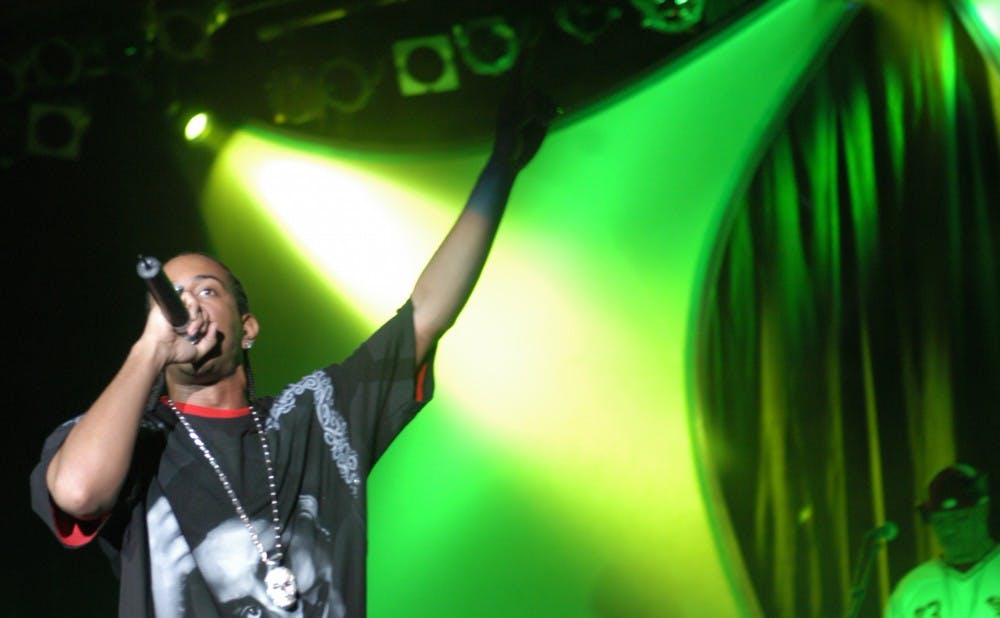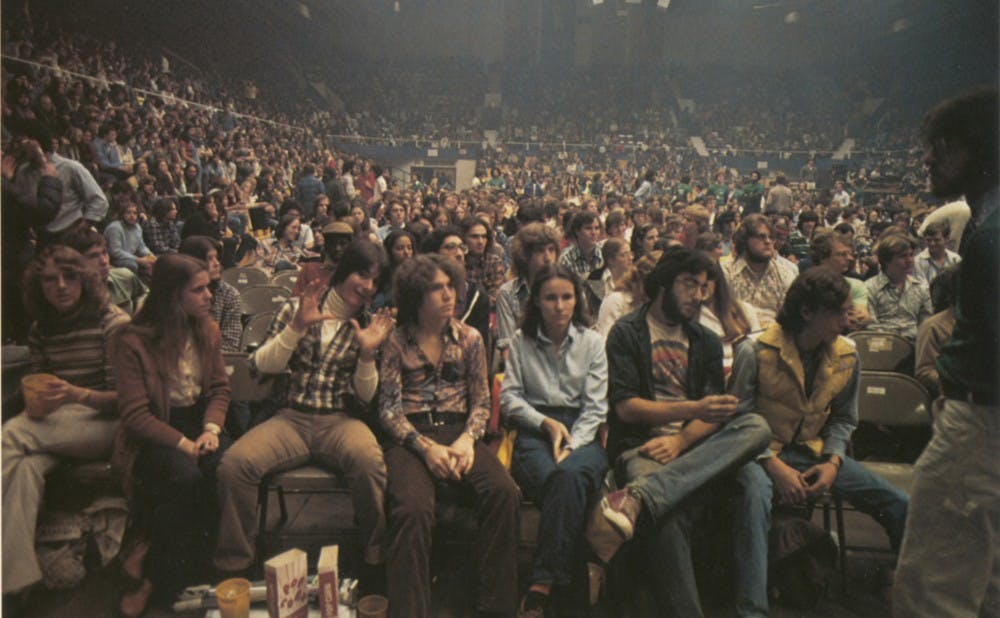Wednesday is LDOC, which means students will be celebrating with a day of activities culminating in an outdoor concert. But the LDOC festival is a tradition that’s only 21 years old, starting in 1997, according to the DUU website. In that time, LDOC has changed significantly, as have other concerts on campus.
LDOC
Ten years ago, LDOC was considered an incredibly high-risk event — and it was. Tom Szigethy, associate dean and director of the Student Wellness Center, said the first year he started working at Duke, a woman was allegedly sexually assaulted during the event. They also surveyed the student body and found that 40 percent “couldn’t care less if the whole event went away.” Students felt that LDOC didn’t represent Duke and was “pretty much drunken debauchery.”
Szigethy said that, in 2009, damages to residential halls after the event totaled around $25,000. There were also several hospital and EMS calls for alcohol poisoning. Elizabeth Turner, Trinity ‘10, became co-chair of the LDOC committee in her senior year, and recalled the high costs of the event in her junior year.
“The year before I was chair, when I was a junior, LDOC was not great, not only concerts-wise — we had the highest number of trips to the ER, vandalism and all those things,” Turner said. “And the administration actually threatened to shut LDOC down.”
The following year, Turner and her co-chair focused on changing the message of LDOC, shifting away from the image of excessive drinking. Szigethy was very involved in these initiatives, and they were successful. In the following years, damages dropped to less than $5,000 and hospital calls decreased.

The initiatives included changing rules about the amount of alcohol people could carry, moving the EMS station from inside a residential hall to outside in front of the Chapel and creating other activities throughout the day. The LDOC committee started bringing in more food and water and hosting arts and crafts. Some events, like the Chapel climb, are only open to students who have not been drinking, due to safety concerns. Szigethy said these initiatives provided incentives for delaying drinking and allowed students who choose not to drink to feel included in the festivities.
Moving the EMS station also impacted the culture of LDOC. It led to students starting to look out more for each other because they knew how they could help each other.
“That started to shift some ownership,” Szigethy said of the outdoor EMS station. “Students were [now] owning the issues and staying involved in it rather than just passing it off to the nearest adult that they could find.”
Prevention initiatives also included reducing the number of people on the quad. LDOC advisor Jessie Stellini wrote in an email that in 2010, non-Duke students were barred from the event for the first time. Szigethy said this approach made prevention more cooperative with the Duke student body by focusing on the problems associated with the thousands of non-Duke students attending. Duke students were less defensive and more willing to change behavior as a result.
Concerts in Cameron
Turner was also chair of Major Attractions — now called Campus Concerts — in her senior year. She headed the planning of the last concert in Cameron Indoor Stadium on April 1, 2010, featuring N.E.R.D and Kid Cudi. At that time, Kyle Fox, now associate director for marketing and communications, advised Major Attractions and was involved with the planning as well.
“It was really a roller coaster,” Fox said. “It was the most stressful and most rewarding thing I think that I’ve done professionally.”
Major Attractions was the oldest committee in DUU, established in 1954. Fox said the main reason for the name change was that DUU was trying to use “natural language” that made the committee goals clear from the name. Turner said the change “really bums [her] out” because she felt that it had a historical significance.
From the 1960s to the 1980s, Cameron hosted concerts nearly every year, including such high-profile acts as The Beatles, Simon & Garfunkel, Bruce Springsteen and Santana, according to a pamphlet from Major Attractions. Prior to the 2010 show, the most recent Cameron concert featured T.I. and Clap Your Hands Say Yeah in 2007, Turner’s first year at Duke.
Turner said that concert flopped, only selling about 2,500 tickets of Cameron’s 5,400 capacity. This lack of success led to the three-year hiatus of concerts in Cameron, but Turner wanted to bring it back in her senior year because it was part of a longer history at Duke. She began planning the final Cameron concert in June 2009, before the school year even started.

The concert required more planning than an outdoor show or a Page Auditorium show because Cameron was in regular use. Turner and her team had to schedule around basketball, and the committee needed a full four days for set-up. That set-up included putting down a special floor, building the stage, installing sound equipment and wiring and having a fire marshal inspect the space — which eliminated any dates during the basketball season.
These factors led to further complications in the already-difficult concert planning process, and Fox said the logistical issues may have been a major reason in no longer using Cameron for concerts. Cameron’s 5,400-person capacity also means that DUU must advertise to other schools and the general public to ensure they recoup costs through ticket sales. Fox cited changes in the music industry as well — bands used to tour more and sought to play in college arenas. Further, Cameron was not built solely for concerts, meaning its acoustics are not the best. Coupled with the increased expectations of sound quality due to advancing technology, that quality means that the way bands sound in the space can be a letdown.
Get The Chronicle straight to your inbox
Sign up for our weekly newsletter. Cancel at any time.
Junior Caroline Levine, Campus Concerts chair, wrote in an email that people now also prefer their concerts outdoors, which may help explain today’s lack of concerts in Cameron. Only one concert a year is typically indoors and hosted in Page. Concerts also move indoors on occasion due to rain, but in those cases, Cameron would not be the go-to location due to the need for different sound and lighting equipment.
However, people still look back fondly on concerts in Cameron. Turner’s father told her about seeing Santana and Springsteen play in Cameron, and Jim Hodges, director of conference and event services, recalled seeing Billy Idol in Cameron when he was still in high school.
“I wish for Duke students’ sake that they would do it,” Turner said. “It’s really cool to see a concert in Cameron.”
Looking forward
DUU and its various partners plan to continue to evaluate and improve on events. Levine said Campus Concerts has begun to introduce Penn Pavilion as a rain location because it most closely resembles an outdoor venue, with standing room instead of fixed seats. The Wellness Center has also introduced new initiatives and hopes to establish discussions of prevention for any large event, not just LDOC.
Although Fox no longer works directly with DUU, he said he is interested to see what the organization continues to do in the future. In his 12 years working at Duke, Fox has seen committees combine, disappear, reappear and disappear again. He cited Heatwave as an event that seems like it has been around for a long time, when it actually only started four years ago.
“There’s no barrier to starting a tradition, and then in three or four years having it be something that sticks around forever,” Fox said.

